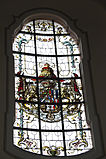St. Johannes Baptist (Dischingen)
The Catholic parish church of St. Johannes Baptist in Dischingen , a community in the Heidenheim district in Baden-Württemberg , was built in the second half of the 18th century by the builder Joseph Dossenberger , a student of Dominikus Zimmermann . The architecture of the Dischingen church combines the forms of late Rococo and early classicism .
history
A first parish church is mentioned in Dischingen for the year 1352. Today's church was built by Prince Alexander Ferdinand von Thurn und Taxis by his court architect Joseph Dossenberger . Within just three years, from 1769 to 1771, the new church was completed. In 1785 the consecration took place by the Augsburg auxiliary bishop Johann Nepomuk August Ungelter . Dischingen belonged to the Diocese of Augsburg until 1812, and in 1821 it was incorporated into the newly created Diocese of Rottenburg .
architecture
Exterior construction
The 48 meter high bell tower rises in the southern corner of the choir. The nave is covered by a hipped roof.
inner space
Balanced proportions characterize the interior of the church. At 45 meters, its length corresponds to the height of the tower (excluding cross and pommel ). The largest width of the nave is 22.50 meters, half of the length and the height of 15 meters is one third of the length.
The nave widens in its middle on both sides to form a slight bulge with an altar. Flat pilasters with Corinthian capitals structure the walls, which are pierced by tall windows and skylights. A basket arch opens the nave in the east to the retracted choir . Two side altars are built into the rounded corners. The patronage boxes of the royal family are located above the doors to the tower and the sacristy .
The stucco was created by the sculptor and plasterer Thomas Schaidhauf, a master of the Wessobrunn school .
Frescoes
The frescoes in the choir and nave were made by Gabriel P. Lucello in 1771/72.
The ceiling painting of the nave depicts the patron saint of the church, John the Baptist , at his penitential sermon. It bears the painter's signature and the year 1772. The four evangelists are shown on the corner pictures framed by stucco cartouches . The coat of arms of Alexander Ferdinand von Thurn und Taxis , the builder of the church, is emblazoned above the choir arch .
The round flat dome of the choir bears a ceiling fresco with a scene of the Revelation of John . It shows the worship of the Lamb by the 24 elders. In the middle, above the lamb, God the Father sits on a throne, surrounded by the symbols of the evangelists . John the Baptist, who seems to be descending into the church, breaks through the lower edge of the picture. He is accompanied by angels, one of whom is holding a banner with the inscription: ECCE AGNUS DEI (this is the Lamb of God).
Leaded glass window
The lead glass windows were made in the Tyrolean glass painting and mosaic institute in Innsbruck and installed on the occasion of the renovation of the church in 1903. The signature GTA INNSBRUCK can be read at the bottom of some panes . Four windows depict the church fathers Ambrosius , Augustine , Gregory the Great and Hieronymus . Two windows have the coat of arms of the House of Thurn and Taxis and the motto PERPETUA FIDE (always reliable and faithful).
organ
The organ was built in 1782 by the organ builder Joseph Höß from Ochsenhausen and is considered to be his only almost completely preserved work.
Furnishing
- The high altar is dedicated to John the Baptist. The two life-size figures on either side of the altar represent his parents, Elisabeth and Zacharias . The altar leaf shows the baptism of Jesus .
- The most valuable piece of equipment is a late Gothic Madonna figure with baby Jesus.
- On the altar in the left hollow of the nave stands another Madonna and Child under an elaborate processional canopy, surrounded by medallions with the secrets of the rosary .
- On the opposite altar, in the right side recess, also under a processional canopy, there is a sculpture of St. Johannes Nepomuk from around 1750.
- The early classicist pulpit was created by Thomas Schaidhauf. At the pulpit you can see Moses receiving the tablets of the Law , and at the back wall John the Baptist at his sermon. The angels on the sound cover hold the symbols of the divine virtues , cross (faith), anchor (hope) and heart (love).
- On the procession poles are St. Ulrich (from 1684), St. Sebastian and St. Joseph depicted.
- The two wooden reliefs under the gallery represent St. Ottilie and probably St. Willibald. The two eyes on the book in the hand of St. Ottilie refer to the legend according to which she was born blind and only received her eyesight through baptism. At the feet of the saints, thanks to her prayer, her father escapes the throat of hell.
- On the modern font is a group of sculptures depicting the baptism of Jesus from the 18th century.
literature
- Hans Schall: Dischingen St. Johannes. (= Kleine Kunstführer No. 105) (first edition 1935), Verlag Schnell und Steiner, Munich (3rd revised edition) 1985.
Web links
Coordinates: 48 ° 41 ′ 50.6 ″ N , 10 ° 21 ′ 42.1 ″ E














